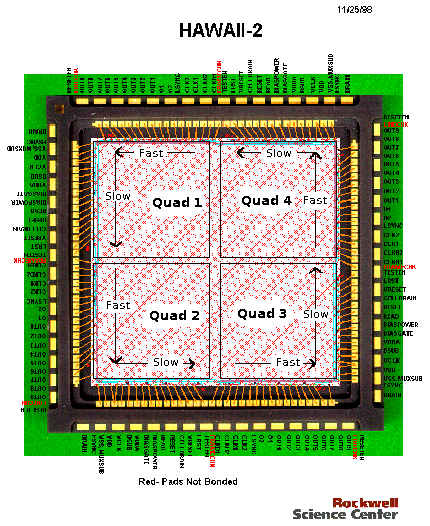NIIS Electronics
HAWAII-2 Array Specifics
NIIS uses the Hawaii-2 PACE 2048x2048 IR array from Teledyne Scientific and Imaging, LLC, a Teledyne Techonologies Incorporated company (formally Rockwell Scientific). This Hawaii-2 array has 18µm pixels with well depths of 100,000 e- and is comprised of four fully independent 1024x1024 quadrants with outputs configured as either 1 per quad or 8 per quad. Each quadrant contains a vertical and horizontal digital shift register for addressing the pixels in the array. The horizontal register requires five clocks where as the vertical register requires only two clocks. To obtain video output, the horizontal register is clocked in the fast direction with the vertical register being clocked in the slow direction. The four quadrants are electrically independent except for the multiplexer substrate and detector substrate connections. Each of the multiplexer quadrants are oriented with the fast (horizontal) and slow(vertial) readout diections as shown in the image below:

The PACE verision of the Hawaii-2 array uses Liquid Phase Epitaxy
(LPE) to deposit detector HgCdTe on sapphire, 2.5µm. According to
the
Gemini NIFS group, the PACE substrate advantages and
dissadvantages
are as follows. Advantages include that this substrate is tried and
proven, is lower risk, lower cost and more redily available.
Disadvantages include a high dark current which limits obserations,
low Quantum Efficiency which varies with temperature, especially
temperatures below 70K, and there are persistence problems such as
bright OH airglow leaving remnants when switching between gratings and
bright standard and reference stars leaving remnants. The image below
is a
cross-sectional view of the Hybrid assembly of a HgCdTe detector. More
specifics on the detector can be found in the table below.

(http://www.mso.anu.edu.au/nifs/codr/codr_detector.htm)
HAWAII-2 specification table:
The specifications apply to array mean values.
| Parameter | Specification | Goal |
|---|---|---|
| Format | 2048x2048 | 2048x2048 |
| Pixel Pitch μm | 18 | 18 |
| Fill Factor | 90 | 90 |
| Quantum Efficiency(77K)@2.3μm | 55% | 75% |
| Long wavelength cutoff μm | 2.5 | 2.5 |
| Short wavelength cut on μm | 0.9 | 0.9 |
| Read noise: multiple sample(e-@77K) | ‹15 | ‹5 |
| Dark Current (e-/s @ 77K, Vb=0.5V) | ‹1 | ‹0.1 |
| Well Capacity (e-, Vb=0.5V) | 60,000 | 100,000 |
| Yield (working pixels) | ›95% | ›99% |
| Temperature | 77K | 77K |